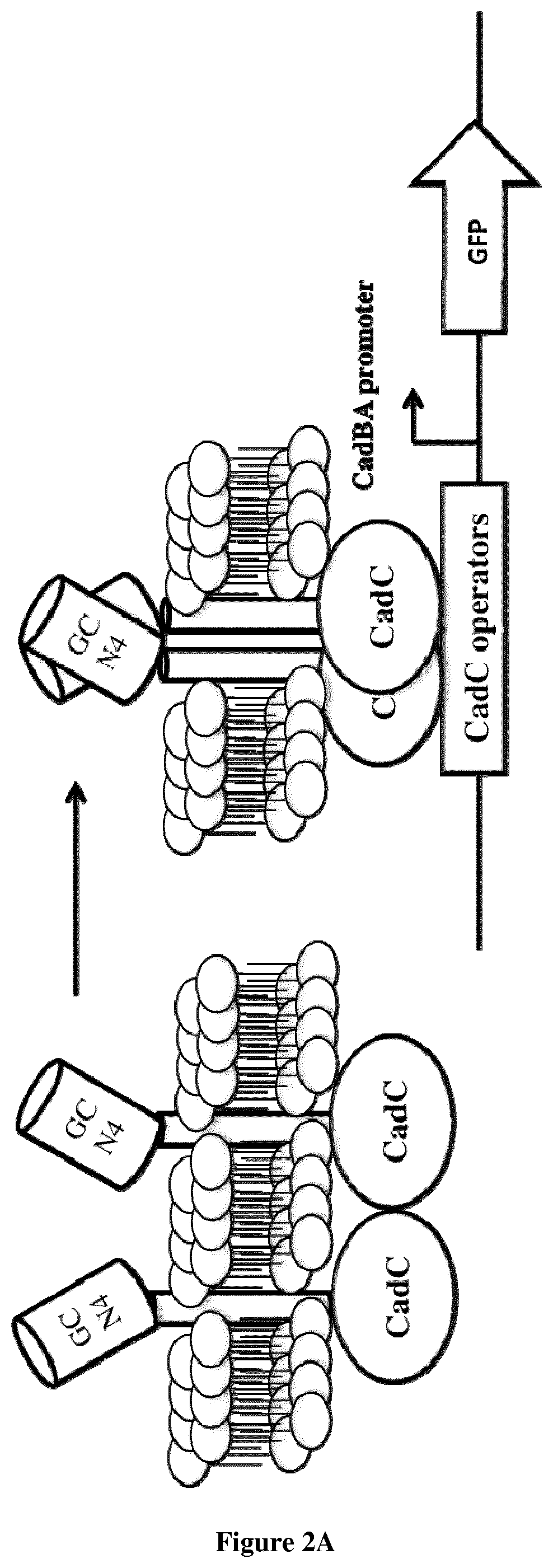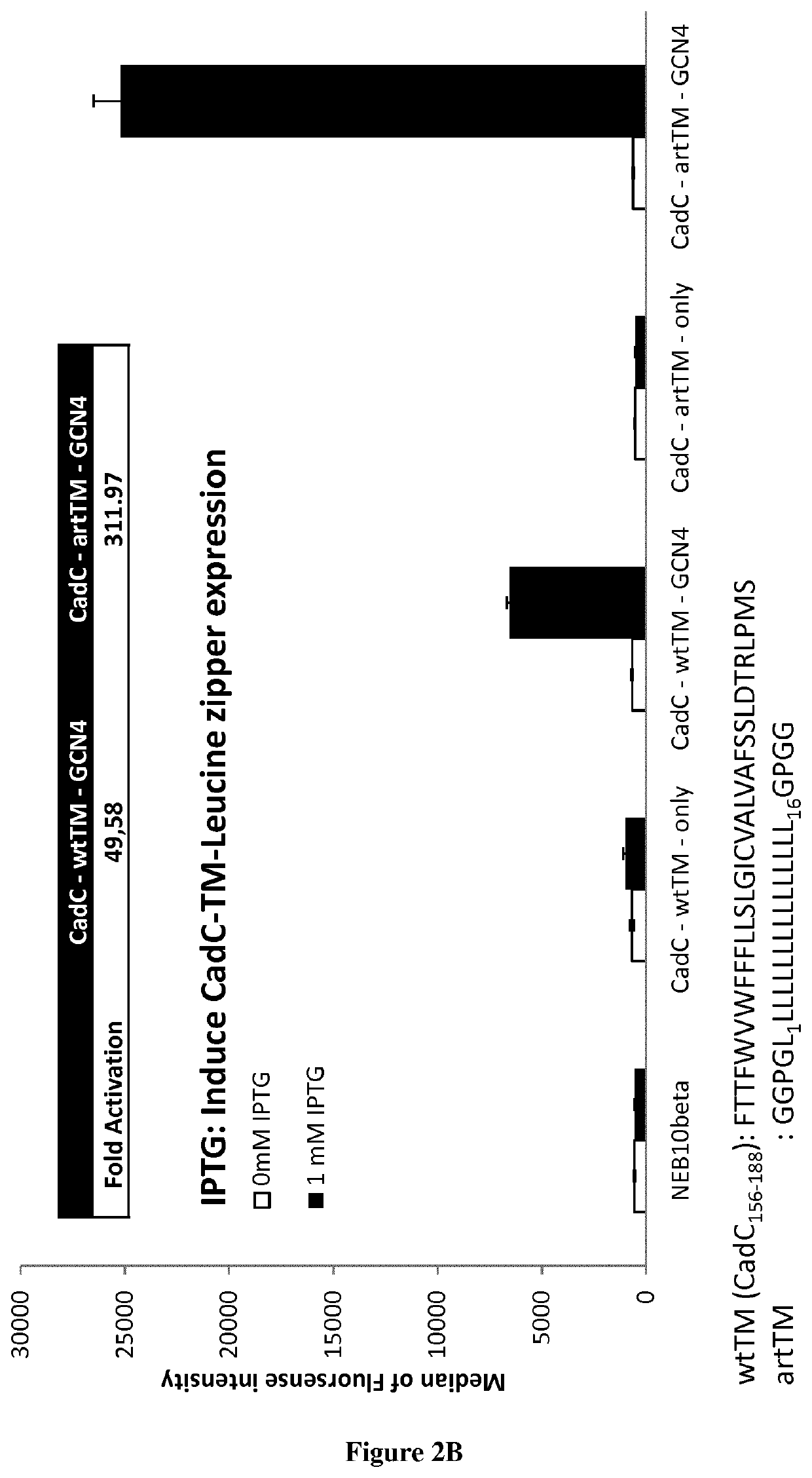Chimeric receptor for use in whole-cell sensors for detecting analytes of interest
a whole-cell biosensor and receptor technology, applied in the field of chimeric receptors, can solve the problems of limited translation of whole-cell biosensors to the clinic, difficult implementation in resource-limited settings, and high cost of conventional detection methods of ivds
- Summary
- Abstract
- Description
- Claims
- Application Information
AI Technical Summary
Benefits of technology
Problems solved by technology
Method used
Image
Examples
example 1
Materials and Methods
Bacterial Strains, Plasmids, and Materials
[0064]CadC and LexA transcriptional factor DNA binding domain, Leucine zipper GCN4, VHHcafe and VHHRNase were synthesized by Integrated DNA Technologies (IDT). Different DNA components such as GFP reporter, CadBA promoter, pLexA promoter and CadC variants were constructed into BioBrick standard vector pSB4K5 by Gibson assembly methods. The resulting constructs were transformed into E.coli strain NEB10beta (New England Biolabs, NEB) and determined their performance. In all constructs, the expression level of CadC variants are under the control of pLac-1 promoter, which can be induced by IPTG. The CadC variants control the expression of reporter GFP through pCadBA promoter.
Design and Construction of CadC Variants
[0065]The sequence details of each construct are listed in supplementary information. The construct CadC operation unit with CadC-wtTM-GCN4 was built first as template for further replacement by other CadC variants...
example 2
Artificial Dimerization of the Cadc Dna Binding Domain Via Leucine Zippers Induces Gene Expression
[0072]Here we fused the CadC DNA binding domain with the wild-type CadC transmembrane region or with an artificial transmembrane region. We then fused these two scaffolds with the GCN4 homodimerizing leucine zipper. We show that while in the abscence of GCN4, nosignal is observed, the constructs fused with GCN4 are able to trigger GFP expression (FIG. 2). Interestingly, the construct using GCN4 fused to the wt CadC transmembrane region produce a ˜50 fold change in GFP expression compare to the construct without GCN4, while the construct using the artificial TM produce a 300 folds fold change.
[0073]While previously it had been demonstrated that forcing dimerization of the CadC DNA binding domain via self-dimerizing transmembrane helixes could trigger downstream gene expression, this is the first demonstration, to our knowledge, that the CadC DNA binding domain and downstream gene express...
example 3
[0074]Engineering a synthetic transmembrane receptor using CadC DBD and a VHH ligand binding domain. One current limitation of whole cell biosensors is the difficulty to detect large biological molecules such as proteins that cannot cross the cellular membrane. While synthetic transmembrane receptors have been developed in mammalian cells, no scalable receptor platform for soluble extracellular ligand detection have been reported in microorganisms, a robust chassis for whole-cell biosensing. We thus aimed at engineering chimeric transmembrane receptors exploiting the principle of split-DBDs. We looked for existing E. coli transmembrane transcription regulators and turned to CadC, a transcriptional activator from the ToxR family. CadC is composed of a N-terminal cytosolic DBD and a C-terminal periplasmic pH sensor domain. It activates the pCadBA promoter when environmental pH decreases and in the presence of lysine. Interestingly, dimerization of transmembrane helixes bound to the cy...
PUM
| Property | Measurement | Unit |
|---|---|---|
| Fraction | aaaaa | aaaaa |
| Fraction | aaaaa | aaaaa |
| Fluorescence | aaaaa | aaaaa |
Abstract
Description
Claims
Application Information
 Login to View More
Login to View More - R&D
- Intellectual Property
- Life Sciences
- Materials
- Tech Scout
- Unparalleled Data Quality
- Higher Quality Content
- 60% Fewer Hallucinations
Browse by: Latest US Patents, China's latest patents, Technical Efficacy Thesaurus, Application Domain, Technology Topic, Popular Technical Reports.
© 2025 PatSnap. All rights reserved.Legal|Privacy policy|Modern Slavery Act Transparency Statement|Sitemap|About US| Contact US: help@patsnap.com



